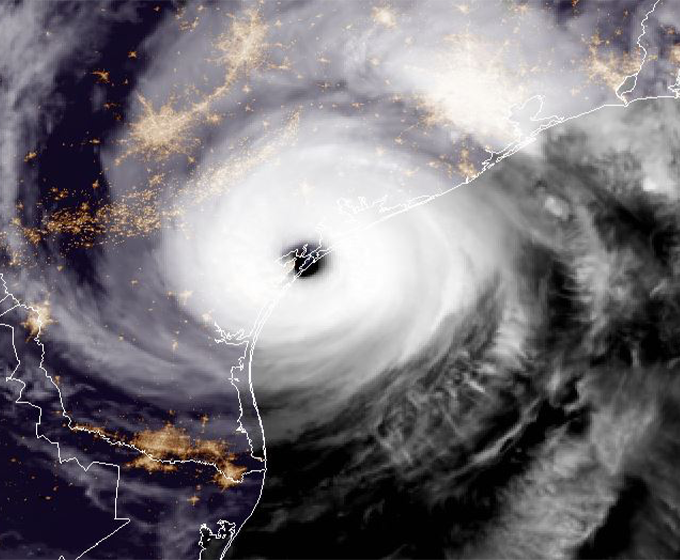
A satellite image of Hurricane Harvey making landfall on the Texas coast on August 25, 2017. (Photo courtesy of Regional and Mesoscale Meteorology Branch)
JULY 22, 2020 — With Texas being a prime target for hurricanes, UTSA’s Center for Cultural Sustainability is launching a two-year effort to improve the resilience of historic buildings along the state’s Gulf Coast so they can better survive severe weather events.
The National Weather Service predicts this year’s U.S. hurricane season will include a higher than average number of storms. As experts anticipate increasingly greater challenges due to climate change, coastal communities must brace for impact. But historic districts—which by their very nature can’t relocate—face unique challenges.
To address this problem, an interdisciplinary team of researchers is turning to historic houses of worship. In addition to technical solutions, the work will establish a Sacred Places Heritage Network for Disaster Resilience, providing support to sacred places listed on the National Register of Historic Places and located within the most impacted areas of Hurricane Harvey damage in 2017.
Backed by emergency supplemental funding from the Historic Preservation Fund, administered by the National Park Service, U.S. Department of the Interior and the Texas Historical Commission, the research project will create connections between multiple faith-based organizations and the communities they serve, empowering them to become more resilient to large-scale disruption.
“Anticipating an increase in frequency and intensity of hurricanes, we must ackowledge that people are what make a place truly sustainable, and people are asking, ‘What can we do to better prepare?’” said William Dupont, who is director of the Center for Cultural Sustainability and holds the San Antonio Conservation Society Endowed Professorship in architecture at UTSA. “Historic places of worship are community anchors, locally supported by committed volunteers and holding collective memories, wisdom and lessons of cultural sustainability. Our project will help them attain higher resilience plus disseminate information on sustainability.”
The direct beneficiaries of the project will be historic buildings used by faith-based organizations. Working through these sacred places, the research team will ensure a greater capacity for them to provide essential social services in response to crises.
Candidates for the network include houses of worship that date to the late 19th or early 20th centuries, are listed on the National Register of Historic Places and are ocated in the FEMA-designated most impacted areas of Hurricane Harvey damage.
Teaming with UTSA to identify and recruit eight to 10 congregations whose buildings will serve as case studies is Philadelphia-based nonprofit Partners for Sacred Places, which aided numerous houses of worship in Galveston following Hurricane Ike in 2008.
Additionally, Houston field offices for the National Trust for Historic Preservation and the American Institute of Architects as well as Galveston Historical Foundation and Victoria Preservation Inc. will assist in case-study selection.
Once case-study structures are chosen, UTSA experts in architecture, historic preservation, construction science and engineering will work to evaluate the structures’ vulnerabilities and recommend changes to address those vulnerabilities—increasing the buildings’ resilience and strength without losing historic character. Engineering faculty from Eastern Michigan University will assist UTSA researchers on the project.
A primary project outcome will be the development and dissemination of a “resiliency roadmap,” a toolkit designed for a nontechnical audience to guide disaster management planning and enhance the capacity of historic sacred places to prepare and recover.
UTSA and its partners hope the faith-based network will become a model for similar disaster and resiliency planning efforts across the nation.
UTSA Today is produced by University Communications and Marketing, the official news source of The University of Texas at San Antonio. Send your feedback to news@utsa.edu. Keep up-to-date on UTSA news by visiting UTSA Today. Connect with UTSA online at Facebook, Twitter, Youtube and Instagram.
Annual Giving will host a First Day of School celebration to welcome students back to campus. We will have giveaways and photo opportunities.
Sombrilla Plaza, Main CampusEnjoy snacks while connecting with Adobe reps and student ambassadors. Download or log into the Adobe Express app to snag swag and unlock exclusive back-to-school templates. It’s a fun, fast way to get creative and start the school year with bold moves.
Central Plaza, Main CampusCelebrate the merger of UTSA and UT Health San Antonio with a pop-up featuring free t-shirts, exclusive swag, and interactive photo opportunities. Open to all students, faculty and staff. Supplies are limited!
Sombrilla Plaza, Main CampusHuddle Against Hunger is a fundraising competition with Texas State that benefits our Roadrunner Pantry. Donations this week will help UTSA earn additional prize monies provided by RBFCU.
In-Person and VirtualJoin UTSA Libraries for an update on federal public access policies and how the library can assist with compliance.
Virtual EventWe invite you to join us for Birds Up! Downtown, an exciting welcome back event designed to connect students with the different departments at the Downtown Campus. Students will have the opportunity to learn about some of the departments on campus, gain access to different resources, and collect some giveaways!
Bill Miller PlazaThere are many citation managers. Which one is right for you? This workshop will explain what a citation manager is and how it can help you organize your citations, insert citations as you write your paper, and generate your bibliography.
Virtual EventThe University of Texas at San Antonio is dedicated to the advancement of knowledge through research and discovery, teaching and learning, community engagement and public service. As an institution of access and excellence, UTSA embraces multicultural traditions and serves as a center for intellectual and creative resources as well as a catalyst for socioeconomic development and the commercialization of intellectual property - for Texas, the nation and the world.
To be a premier public research university, providing access to educational excellence and preparing citizen leaders for the global environment.
We encourage an environment of dialogue and discovery, where integrity, excellence, respect, collaboration and innovation are fostered.